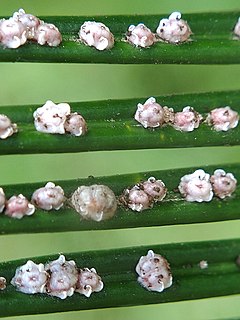 W
WScale insects are small insects of the order Hemiptera, suborder Sternorrhyncha. Of dramatically variable appearance and extreme sexual dimorphism, they comprise the infraorder Coccomorpha which is considered a more convenient grouping than the superfamily Coccoidea due to taxonomic uncertainties. Adult females typically have soft bodies and no limbs, and are concealed underneath domed scales, extruding quantities of wax for protection. Some species are hermaphroditic, with a combined ovotestis instead of separate ovaries and testes. Males, in the species where they occur, have legs and sometimes wings, and resemble small flies. Scale insects are herbivores, piercing plant tissues with their mouthparts and remaining in one place, feeding on sap. The excess fluid they imbibe is secreted as honeydew on which sooty mold tends to grow. The insects often have a mutualistic relationship with ants, which feed on the honeydew and protect them from predators. There are about 8,000 described species.
 W
WScale insects are small insects of the order Hemiptera, suborder Sternorrhyncha. Of dramatically variable appearance and extreme sexual dimorphism, they comprise the infraorder Coccomorpha which is considered a more convenient grouping than the superfamily Coccoidea due to taxonomic uncertainties. Adult females typically have soft bodies and no limbs, and are concealed underneath domed scales, extruding quantities of wax for protection. Some species are hermaphroditic, with a combined ovotestis instead of separate ovaries and testes. Males, in the species where they occur, have legs and sometimes wings, and resemble small flies. Scale insects are herbivores, piercing plant tissues with their mouthparts and remaining in one place, feeding on sap. The excess fluid they imbibe is secreted as honeydew on which sooty mold tends to grow. The insects often have a mutualistic relationship with ants, which feed on the honeydew and protect them from predators. There are about 8,000 described species.
 W
WAntecerococcus is a genus of scale insects. They are found worldwide but with greater abundance in the Old World. There are about 56 species:Antecerococcus albospicatus (Green, 1909) Antecerococcus alluaudi (Marchal, 1904) Antecerococcus andamanensis Hodgson & Williams, 2016 Antecerococcus ankaratrae Antecerococcus asparagi Antecerococcus baccharidis Antecerococcus badius Antecerococcus bryoides Antecerococcus camarai Antecerococcus capensis Hodgson & Williams, 2016 Antecerococcus cistarum Antecerococcus citri Antecerococcus cliffortiae Antecerococcus corokiae Antecerococcus delottoi Hodgson & Williams, 2016 Antecerococcus dumonti Antecerococcus echinatus Antecerococcus eremobius Antecerococcus fradei Antecerococcus froggatti Antecerococcus gabonensis Antecerococcus gallicolus Antecerococcus hilli Hodgson & Williams, 2016 Antecerococcus indicus Antecerococcus insleyae Hodgson & Williams, 2016 Antecerococcus intermedius Antecerococcus kakamegae Hodgson & Williams, 2016 Antecerococcus keralae Hodgson & Williams, 2016 Antecerococcus kurraensis Hodgson & Williams, 2016 Antecerococcus laniger Antecerococcus lizeri Antecerococcus longipilosus Antecerococcus madagascariensis Antecerococcus mirandae Antecerococcus muntingi Hodgson & Williams, 2016 Antecerococcus oranensis Antecerococcus ornatus Antecerococcus oumeensis Hodgson & Williams, 2016 Antecerococcus ovoides Antecerococcus paradoxus Antecerococcus parahybensis Antecerococcus passerinae Antecerococcus perowskiae Antecerococcus philippiae Antecerococcus pileae Antecerococcus pocilliferus Antecerococcus roseus Antecerococcus royenae Antecerococcus ruber Antecerococcus sparsiporus Hodgson & Williams, 2016 Antecerococcus stellatus Antecerococcus steppicus Antecerococcus thesii Hodgson & Williams, 2016 Antecerococcus theydoni Antecerococcus yemenicus Hodgson & Williams, 2016 Antecerococcus zapotlanus
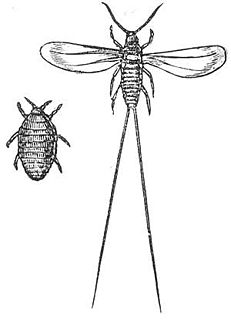 W
WThe cochineal is a scale insect in the suborder Sternorrhyncha, from which the natural dye carmine is derived. A primarily sessile parasite native to tropical and subtropical South America through North America, this insect lives on cacti in the genus Opuntia, feeding on plant moisture and nutrients. The insects are found on the pads of prickly pear cacti, collected by brushing them off the plants, and dried.
 W
WCoelostomidiidae is a family of scales and mealybugs in the order Hemiptera. There are about 5 genera and 11 described species in Coelostomidiidae.
 W
WDactylopius is a genus of insect in the superfamily Coccoidea, the scale insects. It is the only genus in the family Dactylopiidae. These insects are known commonly as cochineals, a name that also specifically refers to the best-known species, the cochineal. The cochineal is an insect of economic and historical importance as a main source of the red dye carmine. It has reportedly been used for this purpose in the Americas since the 10th century. Genus Dactylopius is also important because several species have been used as agents of biological pest control, and because several are known as invasive species.
 W
WDiaspididae is the largest family of scale insects with over 2650 described species in around 400 genera. As with all scale insects, the female produces a waxy protective scale beneath which it feeds on its host plant. Diaspidid scales are far more substantial than those of most other families, incorporating the exuviae from the first two nymphal instars and sometimes faecal matter and fragments of the host plant. These can be complex and extremely waterproof structures rather resembling a suit of armor. For this reason these insects are commonly referred to as armored scale insects. As it is so robust and firmly attached to the host plant, the scale often persists long after the insect has died.
 W
WEriococcidae is a family of scale insects in the order Hemiptera. They are commonly known as felt scales or eriococcids. Each species is usually specific to a different plant host, or closely related group of hosts.
 W
WHalimococcidae is a family of scale insects in the order Hemiptera. Members of the family are commonly known as pupillarial palm scales or halimococcids. Most species are found on the leaves of palm trees where they suck sap, but some species occur on Pandanus. The family was named by Brown and McKenzie in 1962 and includes five known genera and twenty one species.
 W
WThe Kermesidae are a family of scale insects belonging to the superfamily Coccoidea. The type genus, Kermes, includes the kermes scale insects, from which a red dye, also called kermes, is obtained.
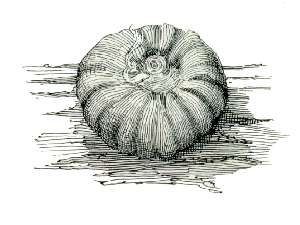 W
WKerriidae is a family of scale insects, commonly known as lac insects or lac scales. Some members of the genera Metatachardia, Tachardiella, Austrotacharidia, Afrotachardina, Tachardina, and Kerria are raised for commercial purposes, though the most commonly cultivated species is Kerria lacca. These insects secrete a waxy resin that is harvested and converted commercially into lac and shellac, used in various dyes, cosmetics, food glazes, wood finishing varnishes and polishes.
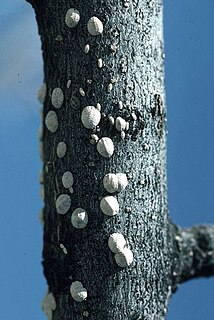 W
WLecanodiaspididae is a family of scale insects commonly known as false pit scales or lecanodiaspidids. Members of this family come from all parts of the world but are most numerous in the Far East.
 W
WThe Margarodidae or ground pearls are a family of scale insects within the superfamily Coccoidea. Members of the family include the Polish cochineal and Armenian cochineal and the original ground pearl genus, Margarodes. Beginning in 1880, a number of distinct subfamilies were recognized, with the giant coccids being the first. Although Maskell proposed a new family, many continued to regard the monophlebids as a mere subfamily for many years, and the Margarodidae classification continued to be polyphyletic through the 20th Century. Since then, taking the advice of Koteja several subfamilies and tribes have been elevated into their own families such as Matsucoccidae and Xylococcidae. The pared-down family of Margarodidae is monophyletic.
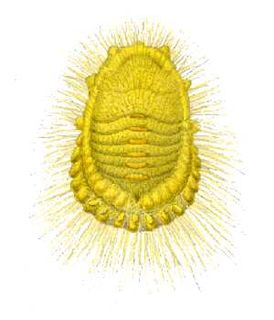 W
WMonophlebidae is a family of scale insects commonly known as the giant scales or monophlebids. They occur in most parts of the world but more genera are found in the tropics than elsewhere.
 W
WOrtheziidae is a family of scale insects commonly known as the ensign scales or ortheziids. They occur in most parts of the world but the majority of the species are found in the Neotropical and Nearctic regions while there are not many species in Australasia and the Far East. There are twenty valid genera and 198 species.
 W
WMealybugs are insects in the family Pseudococcidae, unarmored scale insects found in moist, warm habitats. Many species are considered pests as they feed on plant juices of greenhouse plants, house plants and subtropical trees and also act as a vector for several plant diseases. Some ants live in symbiotic relationships with them, protecting them from predators and feeding off the honeydew which they excrete.
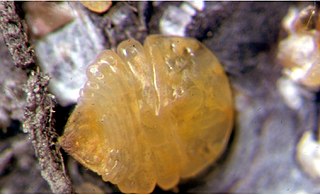 W
WQuadraspidiotus juglansregiae, commonly known as the walnut scale, is a species of armoured scale insect in the family Diaspididae. It is native to North America where it feeds on a wide range of ornamental and forest trees and bushes.
 W
WThe San Jose scale is a hemipterous insect in the family Diaspididae. It is an agricultural pest as it causes damage and crop losses to many fruit crops. In 1914, Q. perniciosus became the first documented case of insecticide resistance.